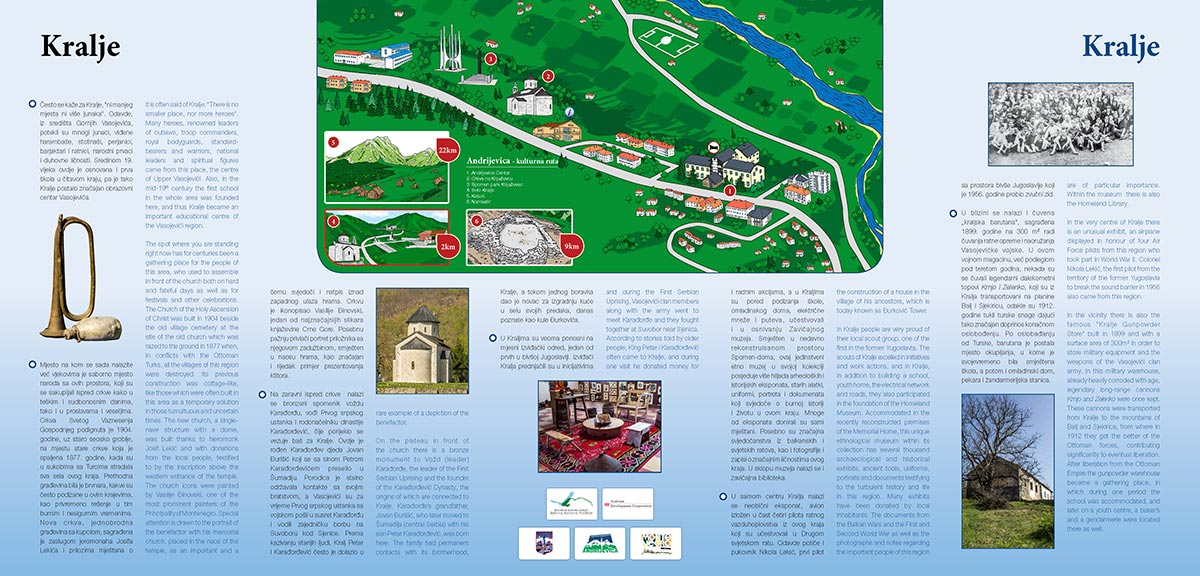It is often said of Kralje: “There is no smaller place, nor more heroes”. Many heroes, renowned leaders of outlaws, troop commanders, royal bodyguards, standardbearers and warriors, national leaders and spiritual figures came from this place, the centre of Upper Vasojevići. Also, in the mid-19th century the first school in the whole area was founded here, and thus Kralje became an important educational centre of the Vasojevići region.
The spot where you are standing right now has for centuries been a gathering place for the people of this area, who used to assemble in front of the church both on hard and fateful days as well as for festivals and other celebrations. The Church of the Holy Ascension of Christ was built in 1904 beside the old village cemetery at the site of the old church which was razed to the ground in 1877 when, in conflicts with the Ottoman Turks, all the villages of this region were destroyed. Its previous construction was cottage-like, like those which were often built in this area as a temporary solution in those tumultuous and uncertain times. The new church, a singlenave structure with a dome, was built thanks to hieromonk Josif Lekić and with donations from the local people, testified to by the inscription above the western entrance of the temple. The church icons were painted by Vasilije Đinovski, one of the most prominent painters of the Principality of Montenegro. Special attention is drawn to the portrait of the benefactor with his memorial church, placed in the naos of the temple, as an important and a rare example of a depiction of the benefactor.
On the plateau in front of the church there is a bronze monument to Vožd (leader) Karađorđe, the leader of the First Serbian Uprising and the founder of the Karađorđević Dynasty, the origins of which are connected to Kralje. Karađorđe’s grandfather, Jovan Đurišić, who later moved to Šumadija (central Serbia) with his son Petar Karađorđević, was born here. The family had permanent contacts with its brotherhood, and during the First Serbian Uprising, Vasojevići clan members along with the army went to meet Karađorđe and they fought together at Suvobor near Sjenica. According to stories told by older people, King Petar I Karađorđević often came to Kralje, and during one visit he donated money for the construction of a house in the village of his ancestors, which is today known as Đurković Tower.
In Kralje people are very proud of their local scout group, one of the first in the former Yugoslavia. The scouts of Kralje excelled in initiatives and work actions, and in Kralje, in addition to building a school, youth home, the electrical network and roads, they also participated in the foundation of the Homeland Museum. Accommodated in the recently reconstructed premises of the Memorial Home, this unique ethnological museum within its collection has several thousand archaeological and historical exhibits, ancient tools, uniforms, portraits and documents testifying to the turbulent history and life in this region. Many exhibits have been donated by local inhabitants. The documents from the Balkan Wars and the First and Second World War as well as the photographs and notes regarding the important people of this region are of particular importance. Within the museum there is also the Homeland Library.
In the very centre of Kralje there is an unusual exhibit, an airplane displayed in honour of four Air Force pilots from this region who took part in World War II. Colonel Nikola Lekić, the first pilot from the territory of the former Yugoslavia to break the sound barrier in 1956 also came from this region.
In the vicinity there is also the famous “Kralje Gunpowder Store” built in 1899 and with a surface area of 300m2 in order to store military equipment and the weapons of the Vasojevići clan army. In this military warehouse, already heavily corroded with age, legendary long-range cannons Krnjo and Zelenko were once kept. These cannons were transported from Kralje to the mountains of Balj and Sjekirica, from where in 1912 they got the better of the Ottoman forces, contributing significantly to eventual liberation. After liberation from the Ottoman Empire the gunpowder warehouse became a gathering place, in which during one period the school was accommodated, and later on a youth centre, a baker’s and a gendarmerie were located there as well.



